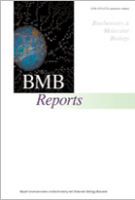
BMB Reports
Scope & Guideline
Exploring the Depths of Biochemical Discovery
Introduction
Aims and Scopes
- Genome Editing Technologies:
BMB Reports extensively covers advancements in genome editing, particularly through CRISPR/Cas technologies, highlighting innovative applications in various organisms and therapeutic contexts. - Cancer Biology and Therapy:
The journal addresses critical aspects of cancer research, including tumor biology, immune evasion, and therapeutic strategies, with a focus on molecular and cellular mechanisms that inform treatment approaches. - Stem Cell Research and Regenerative Medicine:
Research on stem cells, including their differentiation, applications in regenerative medicine, and therapeutic potential, is a core area of focus, reflecting the journal's commitment to advancing this field. - Metabolism and Disease:
BMB Reports explores the link between metabolism and disease, including studies on metabolic reprogramming in cancer, diabetes, and neurodegenerative diseases, integrating molecular insights into broader health implications. - Immunology and Inflammation:
The journal publishes research on immune responses, inflammatory processes, and the role of immune cells in various diseases, showcasing the interplay between immune mechanisms and disease pathology. - Epigenetics and Gene Regulation:
Epigenetic modifications and their roles in gene regulation, development, and disease are prominently featured, highlighting the complexity of gene expression control in various biological contexts.
Trending and Emerging
- CRISPR and Genome Editing Innovations:
The surge in publications focusing on novel CRISPR applications, including base editing and epigenome editing, reflects a growing interest in refining and expanding genome editing technologies for therapeutic purposes. - Cancer Immunotherapy Advances:
Research on immunotherapy, particularly involving immune checkpoint inhibitors and CAR T-cell therapies, is increasingly prominent, showcasing the journal's commitment to addressing cancer treatment challenges. - Microbiome Research:
Emerging studies linking the microbiome to various diseases, including cancer and metabolic disorders, indicate a trend towards understanding host-microbiome interactions and their therapeutic implications. - Neurobiology and Neurodegenerative Diseases:
There is a noticeable increase in research focused on neurodegenerative diseases, with studies exploring molecular mechanisms and potential therapeutic interventions, reflecting a growing interest in brain health. - Single-Cell and Multi-Omics Approaches:
The adoption of single-cell sequencing and multi-omics technologies is trending, as researchers seek to unravel complex biological systems at unprecedented resolution, emphasizing the journal's alignment with cutting-edge methodologies.
Declining or Waning
- Traditional Genetic Engineering Techniques:
While genome editing remains a vital area, the focus on traditional genetic engineering methods seems to be waning as CRISPR and other advanced techniques dominate the narrative. - Basic Virology Studies:
Research centered solely on basic virology, without integration into broader molecular or therapeutic contexts, appears to be less prevalent, possibly due to the increased emphasis on translational research. - Plant Biotechnology:
Although plant biotechnology is still relevant, its prominence has decreased in favor of more applied and translational approaches in mammalian systems, reflecting a shift towards human health applications.
Similar Journals

JOURNAL OF DERMATOLOGICAL SCIENCE
Fostering Innovation in Skin Health and DiseaseThe Journal of Dermatological Science is a premier peer-reviewed publication dedicated to advancing knowledge in the field of dermatology, biochemistry, and molecular biology. Established in 1990 and published by Elsevier Ireland Ltd, this esteemed journal has consistently achieved high academic recognition, securing a Q1 ranking in Dermatology and a Q2 ranking in both Biochemistry and Molecular Biology as of 2023. With a notable impact factor and a Scopus rank that places it within the top tier of dermatology journals globally, it serves as a critical platform for researchers, clinicians, and academicians to disseminate their findings and foster innovation in skin health and disease management. Although the journal is not open access, it provides essential insights into cutting-edge research, clinical practices, and molecular mechanisms underlying dermatological conditions. The Journal of Dermatological Science is not only a vital resource for high-quality articles but also a driving force in shaping the future landscape of dermatological research.

BIOSCIENCE REPORTS
Driving Progress in Biochemical and Cellular ResearchBIOSCIENCE REPORTS, published by Portland Press Ltd, is a prestigious journal dedicated to advancing the fields of biochemistry, biophysics, cell biology, and molecular biology. Founded in 1981, the journal has established itself as a vital resource for researchers and professionals, boasting a significant impact factor and high rankings within its categories, including Q2 in Biochemistry and Q1 in Biophysics as of 2023. The journal’s commitment to high-quality, peer-reviewed research ensures that it remains an influential platform for the dissemination of cutting-edge scientific findings. While it operates under a traditional subscription model, it offers various access options to accommodate the needs of the scientific community. With ongoing publication through 2024, BIOSCIENCE REPORTS continues to play a crucial role in shaping discussions in the life sciences and fostering innovative research in biology.

FASEB BioAdvances
Elevating Understanding of Biological Processes GloballyFASEB BioAdvances, published by WILEY, is an esteemed open-access journal dedicated to advancing the fields of biochemistry, molecular biology, and physiology. Since its inception in 2019, the journal has rapidly established a significant presence within the academic community, boasting an impressive impact factor reflective of its Q2 and Q3 standings across various categories, including Biochemistry, Genetics and Molecular Biology, Cancer Research, Molecular Medicine, and Physiology. The journal aims to disseminate high-quality research and innovative findings to enhance the understanding of biological processes, making it a vital resource for researchers, professionals, and students alike. With its commitment to open access, FASEB BioAdvances ensures that groundbreaking research is available to a global audience, facilitating collaboration and exploration in these rapidly evolving scientific domains.

Microbial Cell
Pioneering discoveries in biochemistry and molecular biology.Microbial Cell is a distinguished open-access journal published by SHARED SCIENCE PUBLISHERS OG, focusing on the dynamic fields of microbiology, biochemistry, and molecular biology. Since its establishment in 2014, Microbial Cell has been at the forefront of disseminating cutting-edge research essential for advancing our understanding of microbial functions and interactions. With a commendable impact factor and ranking in the top quartiles (Q1 and Q2) across several categories, including Applied Microbiology and Biotechnology and Parasitology, this journal serves as an invaluable resource for researchers, professionals, and students alike. It features a comprehensive scope that encompasses the latest findings in genetics, cell biology, and virology, facilitating the academic community's access to high-quality peer-reviewed work. Microbial Cell not only contributes to advancing microbial sciences but also fosters an inclusive platform for knowledge sharing and collaboration in the scientific community.

CELL RESEARCH
Illuminating the Pathways of Life SciencesCELL RESEARCH is a premier peer-reviewed journal dedicated to advancing the field of cell biology and molecular biology, published by SpringerNature. With an impressive impact factor and consistently ranking in the Q1 quartile for both cell biology and molecular biology, this journal serves as a pivotal resource for researchers, professionals, and students seeking to explore the latest discoveries and advancements in cellular mechanisms and their implications for health and disease. Since its inception in 1996, CELL RESEARCH has cultivated a distinguished reputation, currently boasting ranks in the top percentile of Scopus categories, reaffirming its influence and relevance to the scientific community. Although it is not an Open Access journal, its rigorous selection process ensures the publication of high-quality articles that contribute significantly to our understanding of life sciences. For those deeply engaged in the realms of biochemistry, genetics, and molecular biology, CELL RESEARCH is an essential conduit of innovative research and critical insights.

Cell Death & Disease
Unraveling the complexities of cell death and disease mechanisms.Cell Death & Disease, published by SpringerNature, is a premier open-access journal dedicated to disseminating high-quality research on the mechanisms and implications of cell death, disease pathology, and therapeutic responses. Since its inception in 2010, the journal has quickly established itself within the top tier of academic publishing, achieving a notable impact factor and earning Q1 rankings in several critical categories including Cancer Research, Cell Biology, Cellular and Molecular Neuroscience, Immunology, and Medicine (miscellaneous). With its commitment to open access, Cell Death & Disease ensures that groundbreaking research is available to a global audience, fostering collaboration and advancing knowledge across disciplines. Residing at the forefront of crucial scientific discourse, this journal not only attracts submissions from leading researchers but also significantly influences the fields of molecular biology, immunology, and neurology. By bridging the gap between basic science and clinical applications, it provides vital insights for professionals, academicians, and students alike.

Cell Communication and Signaling
Advancing the Frontiers of Cellular InteractionsCell Communication and Signaling is a premier peer-reviewed journal published by BMC that has made significant contributions to the fields of biochemistry, cell biology, and molecular biology since its establishment in 2003. As an open access journal, it offers unrestricted access to high-quality research, fostering collaboration and innovation among scientists around the globe. The journal is distinguished by its Q1 ranking in all three relevant categories for 2023, underscoring its critical role in advancing the understanding of cellular communication mechanisms and signaling pathways. Positioned within the United Kingdom, Cell Communication and Signaling has been an invaluable resource for researchers, professionals, and students alike, ensuring that the latest findings are accessible to a diverse range of audiences. With an impressive Scopus ranking—placing it in the top percentiles within its subject areas—this journal continues to set the standard for excellence in the pursuit of understanding complex cellular interactions.

Cell and Bioscience
Elevating the Standards of Cellular and Bioscience InquiryCell and Bioscience is a prestigious open-access journal published by BMC that has been at the forefront of biochemistry, genetics, and molecular biology since its inception in 2011. With an impressive impact factor, this journal has established itself as a vital resource for researchers and professionals in these rapidly advancing fields, reflecting its high ranking of #29 out of 221 in the Scopus classification and placing it in the 87th percentile. Based in the United Kingdom, Cell and Bioscience aims to foster innovation and dissemination of research findings addressing critical biological questions through rigorous peer-reviewed articles and inter-disciplinary approaches. The journal's open-access model ensures unrestricted access to transformative research, promoting collaboration and knowledge sharing among academics, students, and practitioners worldwide. With a commitment to maintaining excellence in the field, Cell and Bioscience provides an essential platform for those looking to contribute to the evolving landscape of biosciences.

CELLULAR & MOLECULAR BIOLOGY LETTERS
Bridging Gaps in Cellular Research for a Global AudienceCELLULAR & MOLECULAR BIOLOGY LETTERS, published by BMC, is a premier open-access journal dedicated to disseminating high-quality research in the fields of Biochemistry, Cell Biology, and Molecular Biology. Established in 1996, the journal has emerged as a leader in its domain, boasting an impressive Q1 ranking across three critical categories as of 2023, reflecting its significant impact within the scientific community. With an ISSN of 1425-8153 and an E-ISSN of 1689-1392, it offers accessible research findings to a global audience, having been open access since 2013. Situated in the United Kingdom, at CAMPUS, 4 CRINAN ST, LONDON N1 9XW, the journal continues to serve as a vital resource for researchers, professionals, and students, contributing to advancements in the understanding of cellular and molecular processes. By providing a platform for original research, reviews, and short communications, CELLULAR & MOLECULAR BIOLOGY LETTERS plays a crucial role in fostering dialogue and collaboration within the scientific community.

ACTA BIOCHIMICA ET BIOPHYSICA SINICA
Advancing the Frontiers of Biochemical and Biophysical Research.ACTA BIOCHIMICA ET BIOPHYSICA SINICA, an esteemed journal published by SCIENCE PRESS, is a leading platform in the fields of biochemistry, biophysics, and molecular biology. Based in the United Kingdom, this journal has consistently ranked in the Q2 category for Biochemistry, Biophysics, and Medicine (miscellaneous) in 2023, showcasing its commitment to high-quality research and innovation in life sciences. With a convergence period extending from 1996 to 2024, it features critical insights into biochemical and biophysical processes that underlie biological phenomena. Researchers and professionals seeking to stay at the forefront of discoveries will find its articles to be both informative and transformative. Although not an open-access journal, ACTA BIOCHIMICA ET BIOPHYSICA SINICA aims to advance knowledge and foster collaboration among scientists worldwide, emphasizing its role in the dynamic landscape of biomedical research.